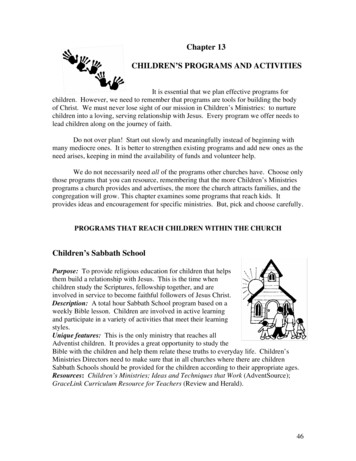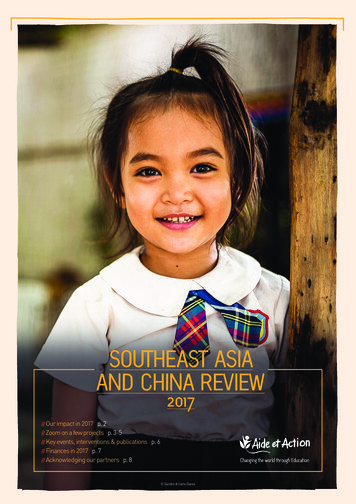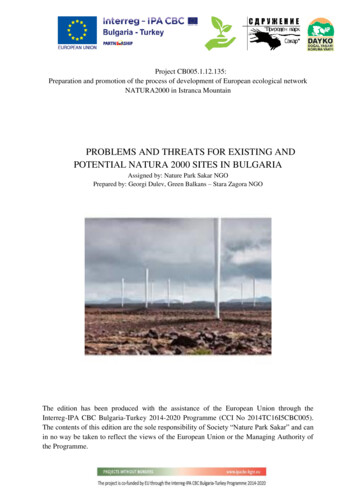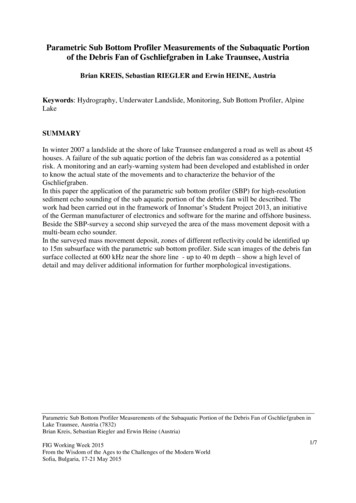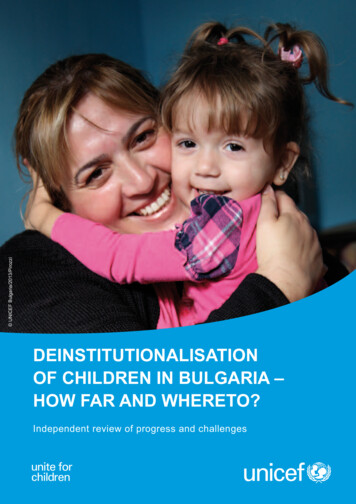
Transcription
UNICEF Bulgaria/2013/PirozziDEINSTITUTIONALISATIONOF CHILDREN IN BULGARIA –HOW FAR AND WHERETO?Independent review of progress and challenges
DEINSTITUTIONALISATIONOF CHILDREN IN BULGARIA –HOW FAR AND WHERETO?Independent review of progress and challengesSofia, June 2014
This publication was prepared by Joanna Rogers, Consulting Group CEE/CIS Partnership for Every Child, as perUNICEF Bulgaria assignment. The opinions expressed in this publication are those of the contributors, and donot necessarily reflect the policies or views of UNICEF. The publication should be quoted in any republication ofmaterial - all or parts of it.DEINSTITUTIONALISATION OF CHILDREN IN BULGARIA - HOW FAR AND WHERETO?Independent review of progress and challenges 2014 United Nations Children‘s Fund (UNICEF)June 2014Permission is required to reproduce the text of this publication. Please contact the Communication sectionof UNICEF BulgariaUnited Nations Children‘s Fund (UNICEF)Blvd Dondukov 87, floor 2Sofia 1054, BulgariaCover photo: UNICEF Bulgaria/2013/PirozziFor further information, please visit the UNICEF Bulgaria website at www.unicef.bg
introductionThe Child Care System Reform with focus on de-institutionalization is a process of deep social changethat most countries of Central and Eastern Europe and the CIS countries are undergoing. A process ofchange that begins with a system, offering placement in institutions as the only answer to the problemsof children and families and aims at creatinga different one – a child care system that offers supportand ensures that risks of family separation are adequately addressed. The implementation of this newsystem requires many changes in various structures, legislation, services and processes. But moreover,it necessitates a change in the minds and hearts of people. UNICEF is a partner to the Governmentof Bulgaria in making this social change happen since the establishment of the country office in 2006.The progress Bulgaria has achieved was also acknowledged at the Ministerial Conference, organizedjointly between Bulgaria and the UNICEF Regional Office for CEE/CIS in December 2012, dedicatedto the progress of the reforms of child protection systems and the process of de-institunalization.The European Union financed for the first time a major program for de-institunalizationin Bulgariathrough its structural funds – the program for implementation of the National Strategy “Vision for deinstitunalization of the children in the Republic of Bulgaria”, adopted in 2010.In the years after 2010, significant progress was achieved with the development of a network of socialservices for support of children and families, the development of alternative family care, many policiesand programs for social inclusion of vulnerable communities and groups. Life improved for manychildren, who remained with their familiesdue to the various services for family support and preventionof family separation and others were transferred from the specialized institutions and placed in fostercare or family type centers. They feel better, develop better, they are part of the community life, theyfound new friends and receive more personal care and attention.As every major social change, the process of de-institunalization needs periodic review andindependent evaluation to answer questions, such as: to what extend the goals have been achievedand are they still valid, have the planned activities been implemented and how the process shall befurther continued. This was also the objective of the State Agency for Child Protection and UNICEF inthe beginning of 2014, when the external evaluation of the implementation of the National strategy forde-institunalization in Bulgaria was commissioned.The quick review of the process of the de-institunalization gives us an opportunity to see how far wehave come, whether the efforts we have put into the process are sufficient and what we still need to doto make our cause successful and achieve a change.Indicative of the right direction we have taken is the evaluation of Joanna Rodgers, saying that thereform of the child care in Bulgaria contributes for the improvement of their well-being and that it willcontinue to have a positive impact on the most vulnerable members of the society.We hope that the report that was prepared will be used by the stakeholders in the country in thediscussion on the priorities and approaches in the ongoing process of de-institunalization, based onthe rights and best interests of every child.Tanja RadocajEva ZhechevaUNICEF Representative for BulgariaChair of SACP
Table of contentsAcknowledgements. 2Glossary. 2Executive Summary. 51. Introduction. 82. Methodology. 83. Summary of the key elements of the Vision and Action Plan 2010-2015. 124. Brief overview of the situation at the outset of the implementation of the Action Plan. 175. Progress to date – overview of the situation in April/May 2014. 196. Conclusions – strengths and weaknesses of the Action Plan and its implementation. 467. Recommendations on possible adjustments to the Action Plan. 65ANNEX 1 List of participants in De-I Review April-May 2014. 83ANNEX 2 A possible framework for an adjusted Action Plan. 86DEINSTITUTIONALISATION OF CHILDREN IN BULGARIA – FAR AND WHERETO?Independent review of progress and challenges1
Executive SummaryThis review was commissioned by UNICEF Bulgaria in order to inform recommendations for theBulgarian Government’s Action Plan for the implementation of the National Strategy ‘Vision for Deinstitutionalisation of Children in Bulgaria’ (hereafter the ‘Action Plan’ and the ‘Vision’), both in theimmediate period through to the end of 2015 and for the medium-term planning period 2015-2020.Over 125 people were consulted during this review and contributed to the findings, conclusions andrecommendations presented in this report. This review is not an evaluation of the implementation of theAction Plan to date, but rather to take stock of the current situation and to strengthen the implementationof the Vision going forward.1. Progress to date - overview of situation in April/May 2014The reduction of numbers of children in institutional care has accelerated and the number ofchildren entering alternative community based family-type care or foster care has increased.The numbers of children in institutional care are falling and especially the proportion of children in Infanthome care has fallen from 0.78% of all children aged 0-3 years at the end of 2009 to 0.43% at the endof 2013. Overall there were 3113 children in all types of institutional care at the end of 2013 or 0.25%of the child population aged 0-17 years.The numbers of children other types of formal care, family-type placement centres and especially fostercare have increased. There were 841 children in foster care at the end of 2011 and 1943 children infoster care at the end of 2013. Over 1000 new foster carers were approved in 2013 alone.The overall number of children in formal care has remained the sameThe numbers of children in formal care overall have not fallen, in fact there were slightly more children informal care at the end of 2013 – 519 children per 100,000 children aged 0-17 - than at the end of 2011.This figures almost doubles if the numbers of children in Guardianship care are added.The system of family support and community based services is being developed across thecountryCommunity based small residential units ‘family-type placement centres’ or’ FTPCs’ are in the processof being built. At the time of the review 103 children had been moved and it is planned that by October2014 around 1400 children and young people with disabilities will be moved into these facilities fromDisability institutions and Infant homes following an extensive planning process based in individualassessments and case conferences for each child and young person.The estimated number of places per 100,000 children in community based services, residential andnon-residential, that are available to children and families differs in each region. Planning has beenbased mainly on individual assessments of children in institutional care. Regional assessment andsocial services development plans have been carried out but have been used to a lesser extent innational planning processes.The pilot closure of eight Infant homes is nearing completionThere has been a reduction in entries to Infant homes from maternity wards and an increase childrenleaving Infant home care in all eight pilot regions. There were only 90 children left in Infant home careDEINSTITUTIONALISATION OF CHILDREN IN BULGARIA – FAR AND WHERETO?2Independent review of progress and challenges
in the eight pilots at the end of 2013 compared to 342 at the end of 2011. 56% of the children leavingthe eight pilot Infant homes left formal care and 39% moved to other types of formal care, mainlyfoster care. 88 of the 90 children remaining at the end of 2013 were with disabilities. The proportion ofchildren with disabilities in Infant home care increased slightly in 2013.The number of children with disabilities in Infant home care in each Region varies widely and this willneed to be taken into account when planning for the restructuring and closure of the remaining 20 Infanthomes in the next Action Plan.It appears that many children who did not enter the eight pilot Infant homes during 2012 and 2013 wereeffectively supported to remain in their families, but the available data does not conclusively confirm thisas the overall numbers of children in formal care remain the same. Data is needed for monitoring thatis disaggregated by age and by Region in order to establish conclusively that prevention of entry intoformal care as a whole has been effective.Regional assessments and social services plans have been developed, but are not being usedfor national decision-making; training and capacity building of social workers has been carriedout as planned, but more is neededNational decision-making processes on deinstitutionalisation, especially for children with disabilitieshave been driving the process of forecasting need for and planning services to date and the Regionalstrategies have been sidelined to some extent. They have potential, however, to be used more fully.Some steps have been taken towards achieving a building of the professional capacity of social workersand other key personnel such as FTPC care staff, specialised foster carers and community basedauxiliary service staff who are of critical importance to the achievement of the goal of the Vision duringthe implementation to date and by October 2014 it is planned that over 2100 social workers will havebeen trained. A longer term view and more systemic approach is required in order to ensure thatworkforce planning for the child care system can meet the current pressures of the deinstitutionalisationprocess and the challenges of the changed system in the months and years ahead.Overall it seems likely that the Action Plan is and will continue to deliver improvements to childwelfareIt is not possible to give an evaluation of whether improvements to child welfare are being achievedin the Action Plan implementation to date without a full, participatory evaluation, but based on theevidence available to this review the following observations can be noted: physically moving children from the isolation which is typical of most Disability institutions into FTPCscased in the community has the potential to bring enormous benefits eventually that will improvechild welfare and well-being; it is understandable that these benefits may not be evident immediatelyas a process of deinstitutionalisation has to take place for the child as well as a process of knitting theFTPCs and into the fabric of the local community – both of these processes can take considerabletime; the foundation appears to have been laid for a foster care system that is accessible to more childrenthan before the Action Plan implementation, this may require consolidation and fine-tuning, but thebenefits of foster care, especially for young children have been well-documented.DEINSTITUTIONALISATION OF CHILDREN IN BULGARIA – FAR AND WHERETO?Independent review of progress and challenges3
2. ConclusionsStrengths that can be built on A Vision with a clear focus and with strong political commitment from the Government. Support andactive engagement for implementing the Vision from a range of stakeholders including the EU, theNGO, professional and academic communities and many Regional and municipal authorities. Thorough, professional and comprehensive individual needs assessments of children in institutionalcare, case conferences and regular reviews forming the basis for decision-making. Successful gatekeeping to prevent entry of children into Infant homes. Creating the infrastructure and preparing the workforce for community-based services (bothresidential and non-residential). Regional assessments and social services development planning that provides a forecast of needfor services that can be used for planning and monitoring.Challenges Prevention and family support services need strengthening in order to identify and address thecauses of child separation. A medical model of disability which constrains the effectiveness of support services for childrenwith disabilities and their families. Community based services for children with disabilities tend tobe separate, parallel services rather than inclusion of children with disabilities into mainstreamkindergartens, schools, social, health and other community services. The danger of children withmultiple disabilities being ‘left behind’ in a system of medicalised residential care. Early interventionservices being seen mainly in terms of maternal and child health services rather than the multidisciplinary services needed to focus on early childhood development. The immediate and urgent need to support the transfer of a large number of children from institutionalcare into community-based FTPCs during 2014 – staff need training and support in order to be ableto manage the process of deinstitutionalisation effectively and to minimise risks. Monitoring data is fragmented and key indicators are not focused on the whole system, but only onsome parts of the formal care system. The Action Plan may have contained inaccurate assumptionsabout the forecasted need for services, these need to be reviewed and planning adjusted using upto date Regional, municipal and national data sets.DEINSTITUTIONALISATION OF CHILDREN IN BULGARIA – FAR AND WHERETO?4Independent review of progress and challenges
3. Recommendations1. Complete the deinstitutionalisation process that has started and continue it into the next period withclosures of the remaining 20 Infant homes, 74 Children’s homes and all 24 Disability institutions andadjust strategic objectives to include whole system reform with an emphasis on preventing childseparation from their family and entry into formal care. Use the ‘necessity and suitability’ principlesfrom the UN Guidelines on Alternative Care for Children to underpin an adjusted Action Plan for2015-2020. A potential structure for an adjusted Action Plan, within the strategic framework of theVision, is elaborated in this report including suggestions for 3 strategic objectives and examples ofindicators and activities.2. Develop a disability policy together with people with disability which addresses the whole life-cycle,is ambitious for children with disabilities and legislates for the provisions of the CRPD and basedon a holistic understanding of disability laid out in the ICF-CY. Ensure an inclusive approach toaccessing mainstream education, employment, housing and other community services and a focuson maximising functioning through access to latest developments in assistive technology. Ensurethat the workforce working with children with disabilities and their families and carers have anunderstanding of disability based on the ICF-CY.3. Re-visit planning assumptions, understand reasons for family separation and build a response basedon municipal and Regional assessments and plans including long-term workforce and social caremarket development strategies.4. Establish a data management and monitoring system with a unified data set from all MLSPdepartments, MoH and MoE which is disaggregated by Region, age, disability, gender and ethnicity.Data should be aggregated from municipalities up through the Regions to the national level.5. Management structures for implementation of the Action Plan should be based on the overall goaland the strategic objectives with joint responsibility for achieving key milestones and interim resultsshared across the sectoral managerial teams in the Ministry of Labour and Social Policy, Ministry ofHealth, Ministry of Education and Ministry of Finance with relevant input from Regional and municipalauthorities and NGOs.6. Develop and implement a long-term strategy for workforce development for social workers , socialcare workers, community workers and disability specialists which is linked to the planning cycles forthe objectives of the Action Plan, the municipal and Regional service development plans to policypriorities.DEINSTITUTIONALISATION OF CHILDREN IN BULGARIA – FAR AND WHERETO?Independent review of progress and challenges5
DEINSTITUTIONALISATION OF CHILDREN IN BULGARIA – FAR AND WHERETO?Independent review of progress and challenges UNICEF Bulgaria/PenovIntroduction
1. IntroductionThis review was commissioned by UNICEF Bulgaria in order to inform recommendations for theBulgarian Government’s Action Plan for the implementation of the National Strategy ‘Vision for Deinstitutionalisation of Children in Bulgaria’ (hereafter the ‘Action Plan’ and the ‘Vision’), both in theimmediate period through to the end of 2015 and for the medium-term planning period 2015-2020. Thisreview was not intended to be an evaluation of the implementation of the Action Plan to date, but ratherto establish the situation in relation to the implementation of the Action Plan at the time of the reviewin April 2014 and to look forward to the coming period. The intention of this review is to strengthen theimplementation of the Vision going forward in the short and longer term.This report presents the key findings from the review, provides an assessment of the impact the childcarereform has had so far on the life of children, gives an evaluation of the strengths and weaknesses of theimplementation of the Action Plan and proposes potential amendments to the Action Plan for discussionwith key stakeholders.The first section of the report presents the methodology used for the review, provides an outline of themain features of the Vision and the Action Plan and then summarises key features of the situation at theoutset of the implementation of the Action Plan at the end of 2010 – the baseline for the implementationin terms of monitoring and evaluation. The second section of the report is structured closely to theobjectives and main activities of the Action Plan, but touches as appropriate on the UNGD criteria ofrelevance, effectiveness, efficiency, inclusiveness and sustainability. The final section of the reportpresents the main recommendations emerging from the review with a focus on possible amendmentsto the Action Plan.DEINSTITUTIONALISATION OF CHILDREN IN BULGARIA – FAR AND WHERETO?Independent review of progress and challenges7
2. MethodologyThe rapid review which informed this report was conducted by an external consultant supportedby a national researcher during April/May 2014. The main methods used to assess the impact ofthe childcare reform to date as at April/May 2014 were an extensive literature review, face-to-faceand telephone interviews, group meetings and focus group discussions with key stakeholders in thereform process. Visits to two regions were undertaken to ensure that the perspectives of children,parents, social services staff, municipal and regional authorities were included in the assessment. Keyinformants included representatives of Government, NGOs and academic bodies at the national levelin Sofia, Regional governors and their teams, municipal mayors and their teams, municipal and nongovernment service providers at the local level, young people in care or who have just left care, parentsand child protection social workers. Consultation with NGOs in Sofia took the form of a group meetingand several individual telephone or face to face interviews. A total of 117 individuals took part in thereview including:8Government representatives11Government experts26NGO representatives18Regional government representatives7Municipal authority representatives20Municipal social services managers and staff8CPD staff2local NGO social services managers and staff5young people12parents and carersA full list of key informants who participated in the review between 13 April and 11 May 2014 is attachedin Annex 1. A further consultation on the first draft of the report was held in Sofia on June 6th 2014 withsome key stakeholders including government and NGO representatives, experts, Regional governmentrepresentatives – comments from the consultation and written submissions following the consultationhave been incorporated into this final version of the report. In total over 125 people have taken part inthe review and contributed to the findings, conclusions and recommendations in this report.Focus group discussions with children, young people and parentsThere was neither the time nor the resources available for this review to ensure a full participatoryconsultation with children. This was partly because some of the reports reviewed included useful andinformative consultations with children who have been impacted by the Action Plan implementation, butalso because of the rapid nature of the review. Focus groups were nevertheless planned in two regionswith young people who are in care or who have left care in the last 2-3 years and with the parents ofchildren with disabilities and of children at risk of losing parental care.By the end of the review 5 young people and 12 parents had taken part in focus group discussions inVratsa and Montana:DEINSTITUTIONALISATION OF CHILDREN IN BULGARIA – FAR AND WHERETO?8Independent review of progress and challenges
3 young men who are living in supported accommodation – 2 care leavers and 1 who had not beenin care 4 mothers of children with disabilities 5 mothers and 2 fathers (including a 17 year old young mother leaving care and the father of herbaby) of children who are current Child Protection Department prevention or reintegration cases 3 clients of CPD and SSC – 1 mother, 1 foster carer and 1 young man aged 20 years old who is aformer client and a current volunteer.Brief observations were made of 18 children living in residential care during visits to a Family TypePlacement Centre and to an Infant Home taking part in Action Plan activities. It was not appropriate,nor was there time, to carry out interviews with the children during these visits.Inquiry frameworkThe inquiry framework for the review focused on assessing the impact to date of the implementationof the Action Plan using the main components of the Action Plan as a structure – objectives, plannedresults and main indicators.The specific research questions that are being put using these instruments are1: To what extent and how the processes of preparation, implementation and management of the ActionPlan correspond to relevant programme and strategic documents at national, regional and municipallevel? To what extent the activities, means, measures, and financing in the Action Plan and their managementcreate pre-conditions for: i) achievement of the objectives of the Vision for DI; ii) establishment of achild-focused child protection system, and iii) alignment with the measures and activities set in theVision? To what extent the Action Plan and its implementation (structures, mechanisms and levels ofmanagement, activities and measures, financing, M&E), as well as the different projects under it,meet the main UNDG criteria - relevance, effectiveness, efficiency, inclusiveness and sustainability? What are the main risks for the implementation of the Action Plan – in the initial phase and in thecourse of its implementation; how are they being identified and addressed? To what extent the preparation, management and implementation of the Action Plan take into accountthe public attitudes, including at local level; what are the activities for raising public awareness andinvolving communities and are they efficient? Does the implementation of the Action Plan lead to improvement of child welfare? What are the main factors that influence the implementation of the Action Plan? To what extent synergy and coordination in the implementation of the Action Plan and its projects atnational, regional and local levels are achieved? To what extent the Action Plan and its implementation is based on the results-based managementapproaches and the human rights based approach to programming? To what extent the different stakeholders (including children and families) feel that they have beenincluded in the planning and implementation of the Action Plan and its different projects?1 From the UNICEF Bulgaria Terms of Reference for the international consultant conducting the ReviewDEINSTITUTIONALISATION OF CHILDREN IN BULGARIA – FAR AND WHERETO?Independent review of progress and challenges9
Table 1. Inquiry framework governing the structure of the reviewAction planobjectivesKey indicators in the Actionplan for each objective1. System offamily/communitybased servicesdeveloped acrossthe country whichexclude child-careinstitutions1. Reduction by 30% ofchildren in any type offormal care; closure of 130institutions.2. Individual child and familyassessment at baseline;improvement in development,health, education attainment,behaviour etc for each child.3. Number of children ininstitutions reduces to zerofrom 7150 in 2010.4. Number and type of noninstitutional services providedto children increases.2. Closure ofresidentialinstitutions;provision of shortand long-termfamily type carefor every child5. Foster care: residential careratio in each region6. Staff/ child ratio in formalcare services7. Reduced number ofchildren in each residentialinstitution.3. Enabling legaland regulatoryframework in placefor objectives1 and 2 to bepossible8. Financial resourcesdedicate to infrastructuredevelopment9. Financial resourcesdedicated to other issues –training, assessment,preparing children10. Increased number oftrained and qualified staff,reduced number of unqualifiedand admin. staff4. Improvedeffectivenessof care systemfor vulnerablechildren andfamilies11. All decisions are in child’sbest interest12. Services provided asplanned13. No negativeconsequences for childrenand familiesUNDG veness andsustainability ofimplementationagainst eachobjective?Indicators in the Actionplan related to UNDGcriteriaEfficiency over 2 years:25,000 children don’tenter institutionsOther keyquestionsRisks andassumptions atthe outset andnow?Public attitudes,awarenessand communityinvolvement;inclusion ofAt a cost of 3,358 EUROchildren andper childfamilies inplanning,Total costs for newimplementation,services will not exceed monitoring?current2 costs of 130institutions.Results-basedand rights-basedCompliance with budget. approaches arebeing used – eg.the necessityQuality of buildings,equipment and vehicles. and suitabilityprinciples3?Amortisation of buildingsAre the rightand equipmentchildren receivingthe right services?7150 children exitinstitutions for betterforms of careAre there groupsof children andfamilies who arenot accessing thebenefits of thereform?The main areas for enquiry for each interviewee or group of key informants with some variations werethe perceived strengths and weaknesses of the Action Plan implementation in relation to:1. Prevention, reintegration and alternative care: for under-3s / older children / children with disabilities /Roma children / children from hard-to-reach rural areas / children living in poverty – other target groups?Are services achieving better care and is this achievement sustainable? Are they child-focused andreaching all children and families who need them? Does each child have an individual assessment andplan? Why/how? Why not?2 At the time of adoption of the Action Plan in November 20103 From the UN Guidelines on Alternative Care for ChildrenDEINSTITUTIONALISATION OF CHILDREN IN BULGARIA – FAR AND WHERETO?10Independent review of progress and challenges
2. How is regional planning and social services system development going in relation to – servicedelivery for prevention and reintegration; service delivery for alternative care; gate-keeping; servicetargeting; links with social protection, education and health sys
The numbers of children other types of formal care, family-type placement centres and especially foster care have increased. There were 841 children in foster care at the end of 2011 and 1943 children in foster care at the end of 2013. Over 1000 new foster carers were approved in 2013 alone.





